The Ribbon Blenders Market is estimated to be valued at USD 23.5 billion in 2025 and is projected to reach USD 59.3 billion by 2035, registering a compound annual growth rate (CAGR) of 9.7% over the forecast period.
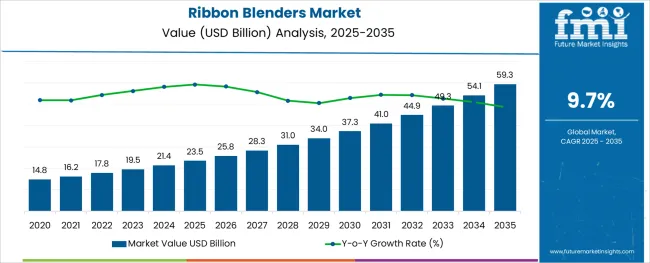
The ribbon blenders market is expanding steadily due to the increasing need for efficient mixing solutions across diverse industries. Growing production volumes in food processing, pharmaceuticals and chemicals have driven the demand for equipment that ensures uniform blending of powders and granular materials. Industry publications have highlighted the importance of equipment that delivers consistent mixing results to meet stringent quality and safety standards.
Product advancements have enhanced energy efficiency and improved cleaning mechanisms which are vital in industries with frequent batch changes. Additionally, the rise in customized manufacturing and small-batch production has increased the adoption of flexible and scalable mixing solutions.
Market growth is expected to continue as automation and process optimization become priorities in industrial manufacturing. Segmental expansion is led by the Food and Beverage Industry as the largest end-user and Horizontal Ribbon Mixers as the most preferred equipment type due to their mixing efficiency and versatility in handling a variety of ingredients.
The market is segmented by End User and Type and region. By End User, the market is divided into Food and Beverage Industry, Chemical and Petrochemical Industry, and Pharmaceutical Industry. In terms of Type, the market is classified into Horizontal Ribbon Mixers and Vertical Ribbon Blenders. Regionally, the market is classified into North America, Latin America, Western Europe, Eastern Europe, Balkan & Baltic Countries, Russia & Belarus, Central Asia, East Asia, South Asia & Pacific, and the Middle East & Africa.
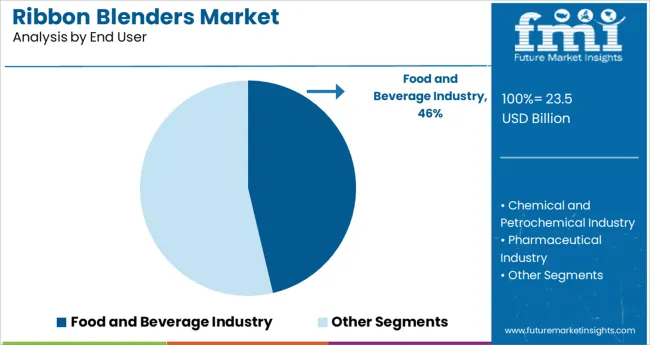
The Food and Beverage Industry segment is projected to contribute 46.3% of the ribbon blenders market revenue in 2025 maintaining its position as the primary end-user. Growth in this segment has been influenced by the rising production of processed foods functional ingredients and ready-to-eat products which require consistent and hygienic mixing. Manufacturers have relied on ribbon blenders for their ability to handle a wide range of food-grade powders spices and additives efficiently.
The demand for equipment that supports compliance with food safety standards and simplifies cleaning processes has further increased the adoption of ribbon blenders in food production facilities. With consumers seeking greater variety and customization in food products food manufacturers have ramped up product development efforts that require adaptable and reliable mixing solutions.
As innovation in food formulations continues the Food and Beverage Industry segment is expected to sustain its growth in the ribbon blenders market.
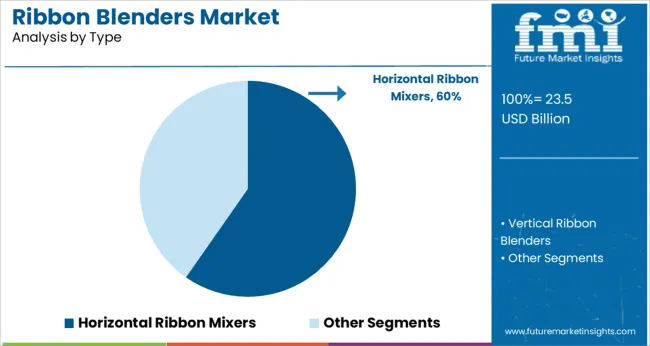
The Horizontal Ribbon Mixers segment is projected to account for 59.7% of the ribbon blenders market revenue in 2025 making it the leading equipment type. Growth of this segment has been driven by the mixers’ proven ability to achieve uniform blending in a short time frame. Industries have preferred horizontal ribbon mixers for their simple yet effective design which combines inner and outer helical ribbons to promote thorough mixing of dry powders and granules.
These mixers have also been appreciated for their ease of maintenance and adaptability to both continuous and batch processing. Users across industries have benefited from the scalability of horizontal ribbon mixers which accommodate both small and large production volumes.
As industrial operations focus on efficiency and consistency the Horizontal Ribbon Mixers segment is expected to maintain its market leadership driven by reliable performance in diverse mixing applications.
Surging consumption of breakfast cereals with the rising popularity of ready-to-eat food items enabled by busy lifestyles of the working population is expected to augment the market.
Rising need for healthy & convenient food, increasing preference for local flavors, and westernization of global diets are set to push cereal consumption in developing countries, thereby accelerating the ribbon blenders market growth.
Moreover, rapid expansion of retail infrastructure, such as hypermarkets and supermarkets in various parts of the globe is set to fuel the demand for breakfast cereals. Increasing number of new product launches with numerous flavors by key players is another crucial factor that would spur growth.
In November 2024, for instance, General Mills, Inc., a multinational food company based in the USA, launched various products to expand its ready-to-eat cereal range. The lineup includes CinnaGraham Toast Crunch, Reese’s Puffs Cluster Crunch, Plentifull, PJ Masks Cereal, and Strawberry Banana Cheerios. Such unique product launches by companies in the breakfast cereal segment is set to foster the requirement of ribbon blenders.
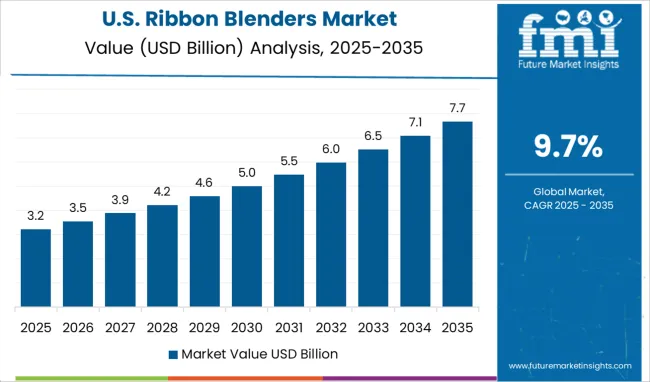
Increasing demand for snack bars among the health-conscious population in the USA and Canada is projected to bolster the North America ribbon blenders market share in future years. Rising replacement of high calorie content products with snack bars in the region is also expected to drive the regional market.
Surging cases of obesity are compelling consumers to opt for nutritious snack bars, which would propel the need for ribbon blenders. As per the Centers for Disease Control and Prevention (CDC), in 2020-March 2024, the prevalence of obesity in the USA was 41.9% and the estimated annual medical cost of obesity was about USD 173 Billion in the country. The trend is set to continue throughout the forthcoming years, thereby fostering the North America market.
Asia Pacific is set to remain in the second position, followed by North America during the forecast period. Launch of customized energy drinks to attract consumers belonging to the age group of 18-34 years in India, China, Japan, and South Korea is likely to augur well for the regional market.
In October 2024, for instance, AB InBev, a multinational drink and brewing company headquartered in Belgium, introduced Budweiser Beats in India. The company aims to expand its non-alcoholic beer and energy drink segments in the country.
It also wants to lower the harmful effects of alcohol by nearly 10% in top 6 cities worldwide by launching energy drinks. On account of new product launches, sales of ribbon blenders are projected to grow in Asia Pacific.
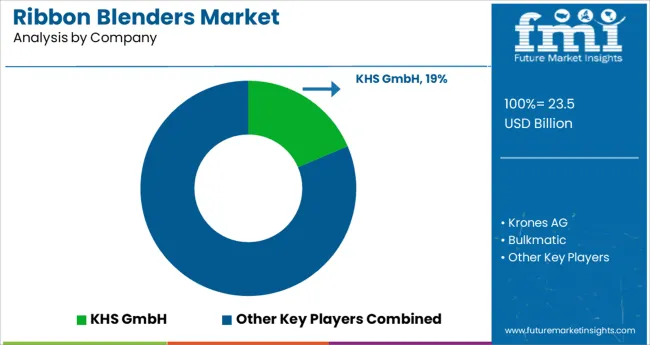
Some of the renowned companies operating in the global ribbon blenders market include Buhler Holding AG, Bulkmatic, Sulzer Ltd., KHS GmbH, Morton Mixers & Blenders, Highland Equipment, SPX Corporation, Tetra Laval International S.A., Lee Industries, Krones AG, Charles Ross & Son, Munson Machinery, Marel hf, Hosokawa Micron Corporation, John Bean Technologies Corporation, and GEA Group AG among others.
The majority of the key players in the market are focusing on research and development activities to introduce state-of-the-art products. They are also collaborating with renowned food and beverage manufacturers to provide their in-house ribbon blenders and gain a competitive edge in the market. Some of the other companies are aiming to generate high shares by engaging in mergers and acquisitions, joint ventures, and capacity expansion strategies.
| Report Attribute | Details |
|---|---|
| Growth Rate | CAGR of 9.7% from 2025 to 2035 |
| Base Year for Estimation | 2024 |
| Historical Data | 2020 to 2024 |
| Forecast Period | 2025 to 2035 |
| Quantitative Units | Revenue in million and CAGR from 2025 to 2035 |
| Report Coverage | Revenue Forecast, Volume Forecast, Company Ranking, Competitive Landscape, Growth Factors, Trends and Pricing Analysis |
| Segments Covered | End User, Type, Region
|
| Regions Covered | North America; Latin America; Western Europe; Eastern Europe; APEJ; Japan; Middle East and Africa
|
| Key Countries Profiled | USA, Canada, Brazil, Argentina, Germany, UK, France, Spain, Italy, Nordics, BENELUX, Australia & New Zealand, China, India, ASEAN, GCC, South Africa |
| Key Companies Profiled | Buhler Holding AG; Bulkmatic, Sulzer Ltd.; KHS GmbH; Morton Mixers & Blenders; Highland Equipment; SPX Corporation; Tetra Laval International S.A.; Lee Industries; Krones AG; Charles Ross & Son; Munson Machinery; Marel hf; Hosokawa Micron Corporation; John Bean Technologies Corporation; GEA Group AG
|
| Customization | Available Upon Request |
The global ribbon blenders market is estimated to be valued at USD 23.5 billion in 2025.
It is projected to reach USD 59.3 billion by 2035.
The market is expected to grow at a 9.7% CAGR between 2025 and 2035.
The key product types are food and beverage industry, chemical and petrochemical industry and pharmaceutical industry.
horizontal ribbon mixers segment is expected to dominate with a 59.7% industry share in 2025.






Full Research Suite comprises of:
Market outlook & trends analysis
Interviews & case studies
Strategic recommendations
Vendor profiles & capabilities analysis
5-year forecasts
8 regions and 60+ country-level data splits
Market segment data splits
12 months of continuous data updates
DELIVERED AS:
PDF EXCEL ONLINE
Printer Ribbon Market Trends – Growth & Forecast 2024-2034
Card Printer Ribbon Market Size and Share Forecast Outlook 2025 to 2035
Thermal Transfer Ribbon Market Growth - Demand & Forecast 2025 to 2035
Blenders Market Insights – Growth & Demand Forecast 2025 to 2035
Portable Blenders Market

Thank you!
You will receive an email from our Business Development Manager. Please be sure to check your SPAM/JUNK folder too.
Chat With
MaRIA